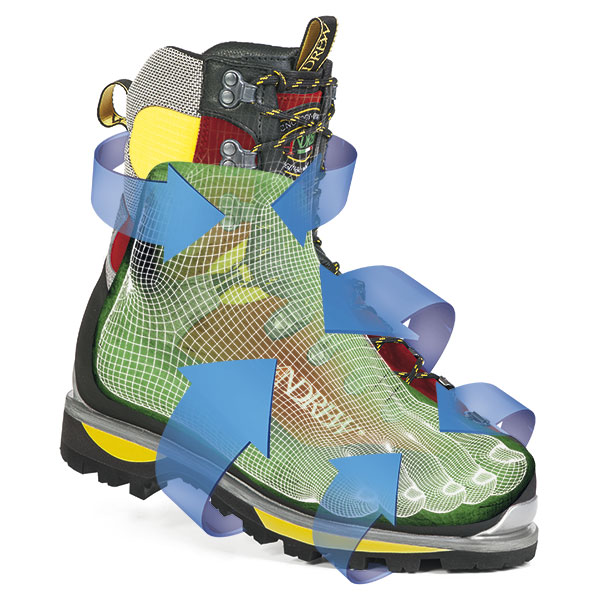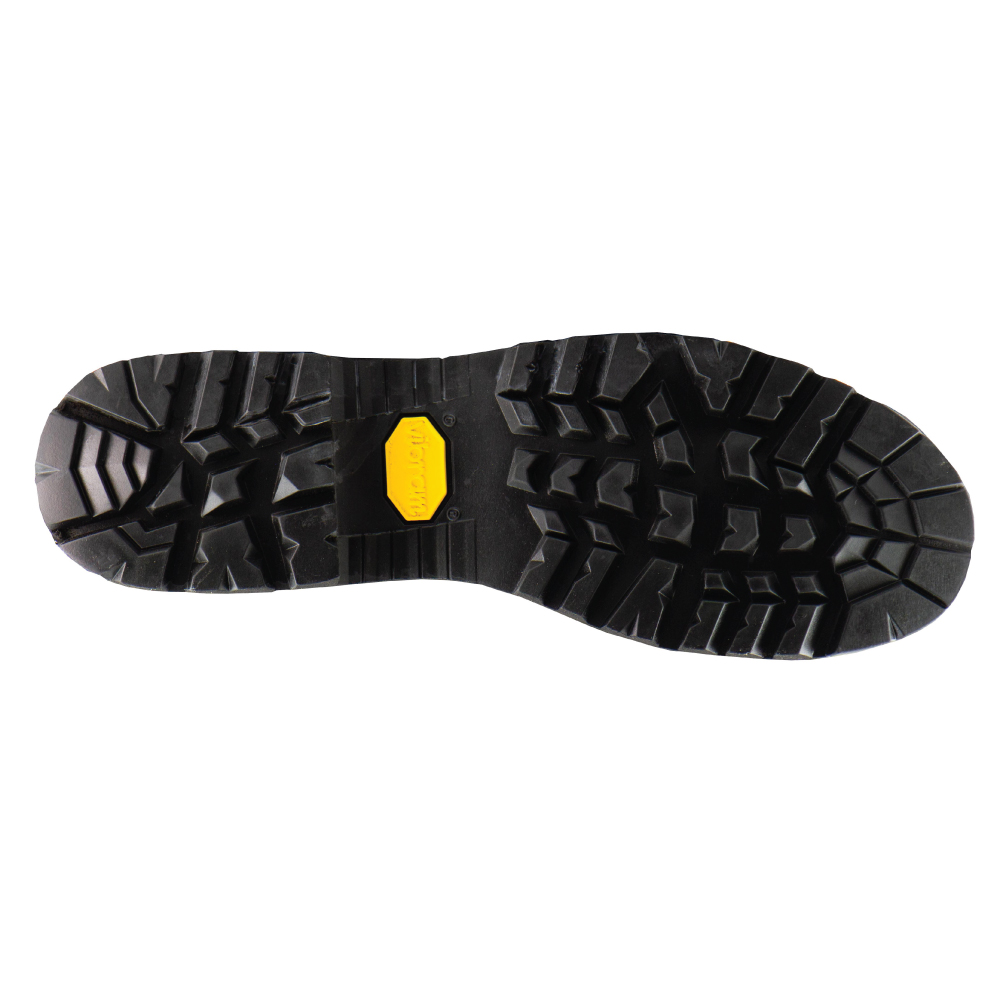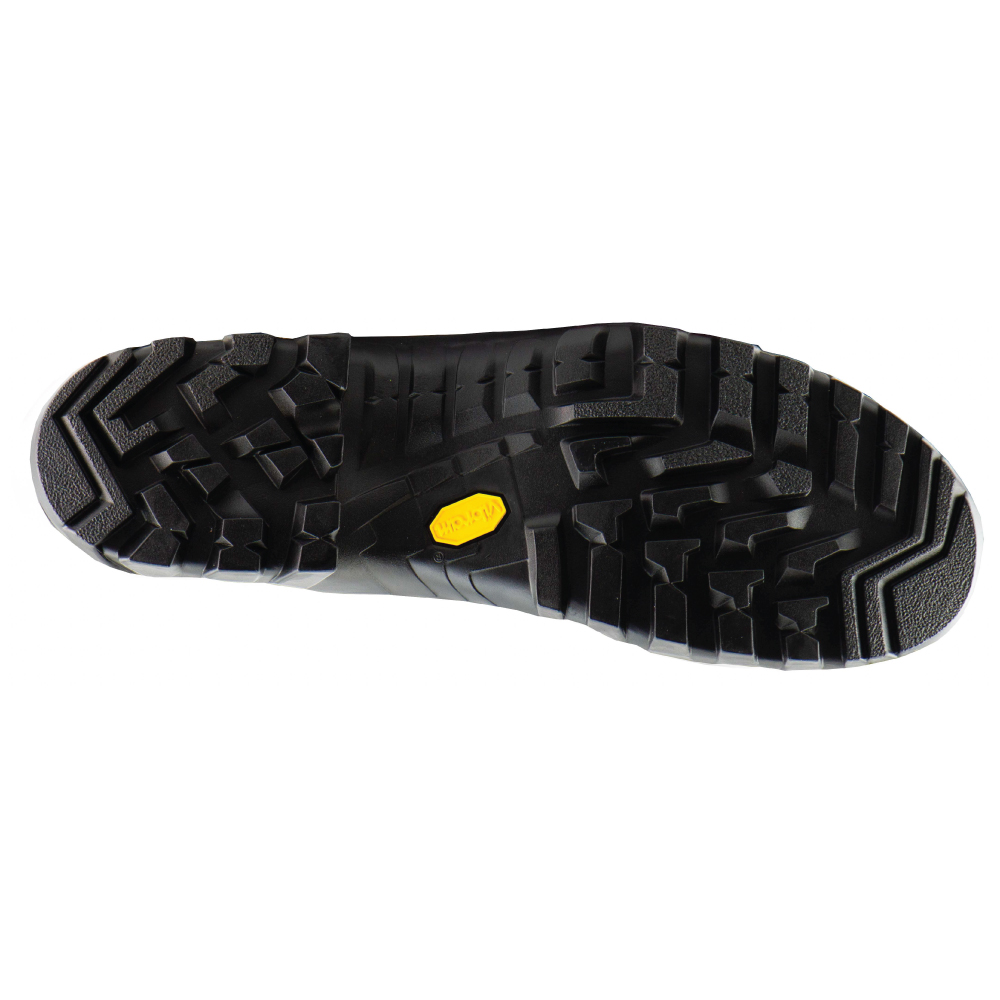Technology:
Every detail of Andrew’s shoes proves the company’s commitment to technical innovation: from design to construction and craftsmanship of the shoes’ components.
Discover the Andrew technology.
Ergonomics
Thanks to an internal volume that supports the natural forms of the foot and a fluid rolling that fits the arch-metatarsus biomechanics system, Andrew shoes establish an ideal balance between flexion and torsion. The progressive absorption and release of energy reduce the stress on the spine and joints.
Insoles & Rigidity
Middle-to-high rigidity, insoles mounted on shoes appropriate for demanding mountaineering, fixed-aid climbing routes, steep ground, and trekking. Resistant and with controlled flexion, with dimensional stability in the presence of temperature changes, designed for use with automatic and semi-automatic crampons.
Medium rigidity, these insoles guarantee that the shoes will bend and roll in an optimal way also when the wearer is carrying medium and heavy loads. Designed for use on mixed terrain, difficult trekking routes, work on the mountains and hunting.
Reduced rigidity, insoles developed for shoes for light trekking, hiking, pathfinding and similar activities, work. Flexible, elastic and insulating.
Foot Bed
Leather/EVA
Washed natural and aerated leather with anatomical Eva support. Breathable, soft and flexible, with open cell shock absorber in the heel impact area. Absorbs the shoe’s inner humidity.
Andrews Midsole System
Exclusive Andrew Srl rigid TPU midsole, designed and produced in a single printed plate with differentiated internal structure. This system copies the lower biomechanics of the foot, guaranteeing structural support, torsional stability, and precision, lightness, sensitivity and shape-holding capability in the areas of maximum adhesion of the sole. Designed for shoes to be used with automatic crampons.
Rigid TPU midsole, with a shell architecture that tapers off from the heel to zero thickness at the metatarsus. This structure is designed to guarantee the right balance of stability, sensitivity and shape-holding capability, and the controlled flexion of the front part of the foot. Used in shoes with slots for semi-automatic crampons.
Variable density polyurethane midsole, designed to streamline tensile strength, shock absorption and micro-vibrations from the impact with the ground in the areas of the heel and metatarsus. It guarantees uniform and stable load distribution, reduces stress to the lower limbs and offers at the same time maximum propulsion. Antistatic, abrasion and puncture resistant, anti-vibration.
New Andrew midsole with technical features similar to T.S.S.L. However, it has an external central support that guarantees an excellent combination of torsion stability, containment and correct flexion of the arch of the foot when the foot is rolling.
Materials
Waterproof Membrane
A new type of waterproof lining laminate to create an excellent micro climate in the shoe. Excellent microclimate in the shoe during extreme physical exertion.
- Prevention of unpleasant damp feeling by faster moisture wicking from the foot to the outside
- Faster drying of the inner lining after exposure to extreme moisture
- Reduction of odour and blister formation
- Maximum wear comfort and dry feet for maximum performance in changing climatic conditions
Outsoles
Vibram 1202 Foura
Rubber sole featuring the classic trekking design by Vibram. For its high non-slip capacity, together with the reinforced toe cap, the undercut heel and the carved waist (for improved adherence to uneven terrain), it is recommended for trekking.
Boots with this sole:
Vibram 1396 Zebru
High grip rubber climbing sole compatible with semi-automatic crampons. The delineated heal offers braking on steep slopes.
Resistant to acids, petrol, and animal manure, for this reason we have in conjunction with a full rubber mid-sole and a full rubber rand designed the Andrew Zebru boot, with the farming community in mind and its harsh working environment.
Boots with this sole:
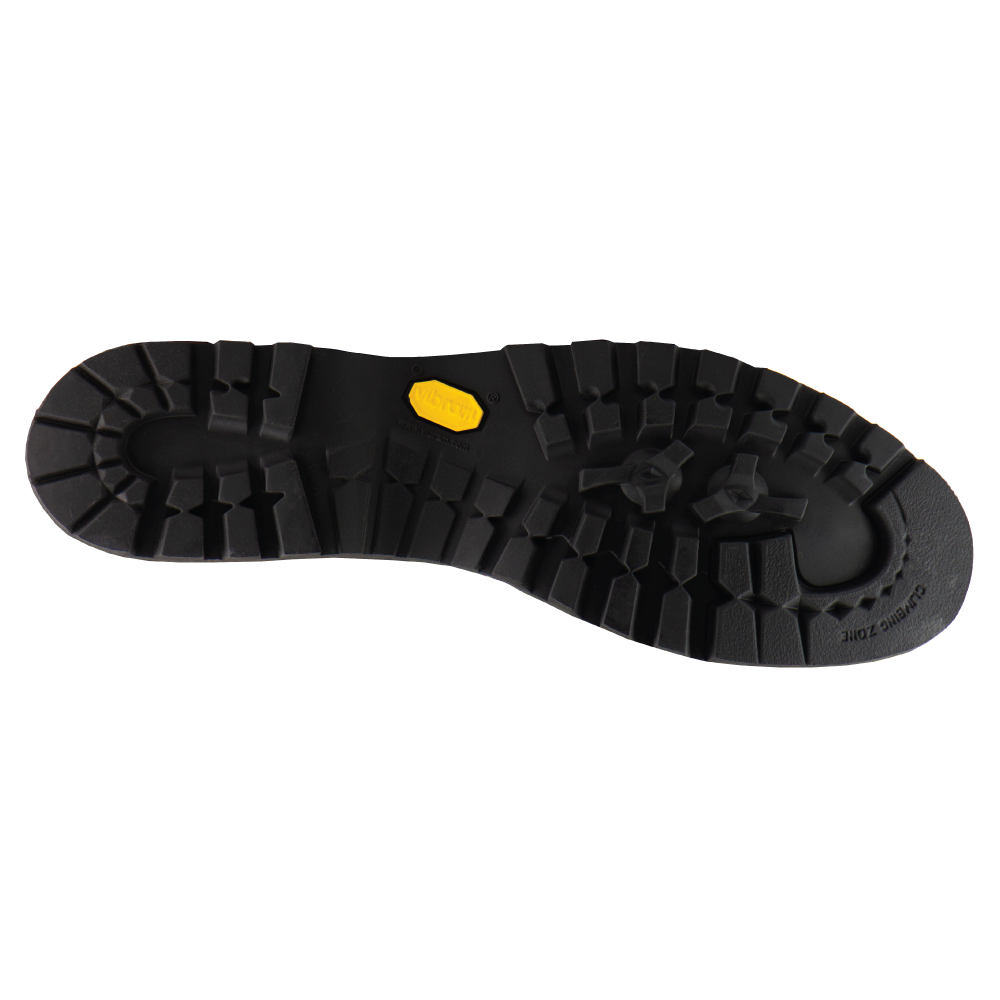
Vibram 1129 Mulaz
Vibram Mulaz adapts to a wide variety of alpine terrain and to the most extreme conditions thanks to a 360° helical tread, which is especially effective when ascending and descending. The broad support surfaces at the tip (Climbing Zone) are particularly useful in rocky passages where grip is essential.
Boots with this sole:
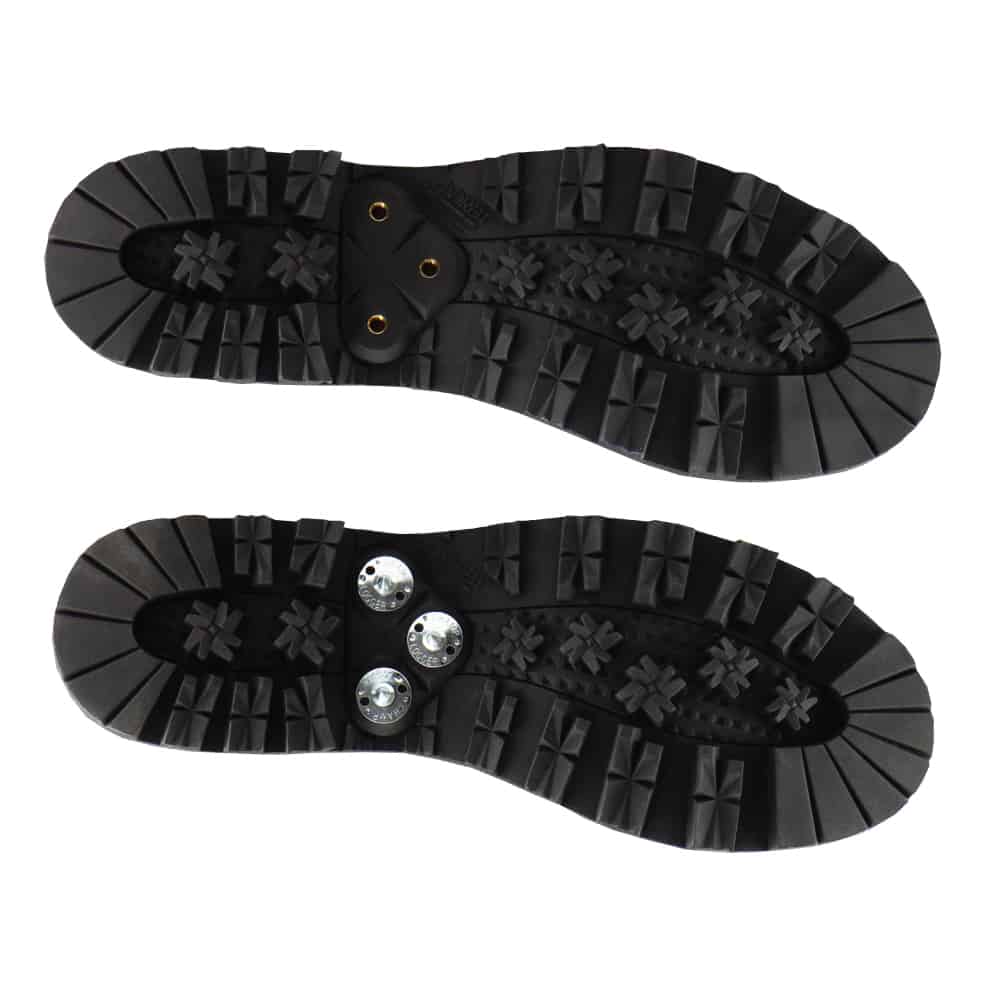
Andrew Magma
A high-performance outsole designed for the extreme outdoors with great traction and grip and hardwearing. Comfortable heel-to-toe motion, and sure grip on slippery surfaces.
Designed to use with optional studs for extra grip. Studs need to be screwed into the receptacles placed in the arch area of the sole.
Resistant to acids, petrol, and animal manure.
Boots with this sole:
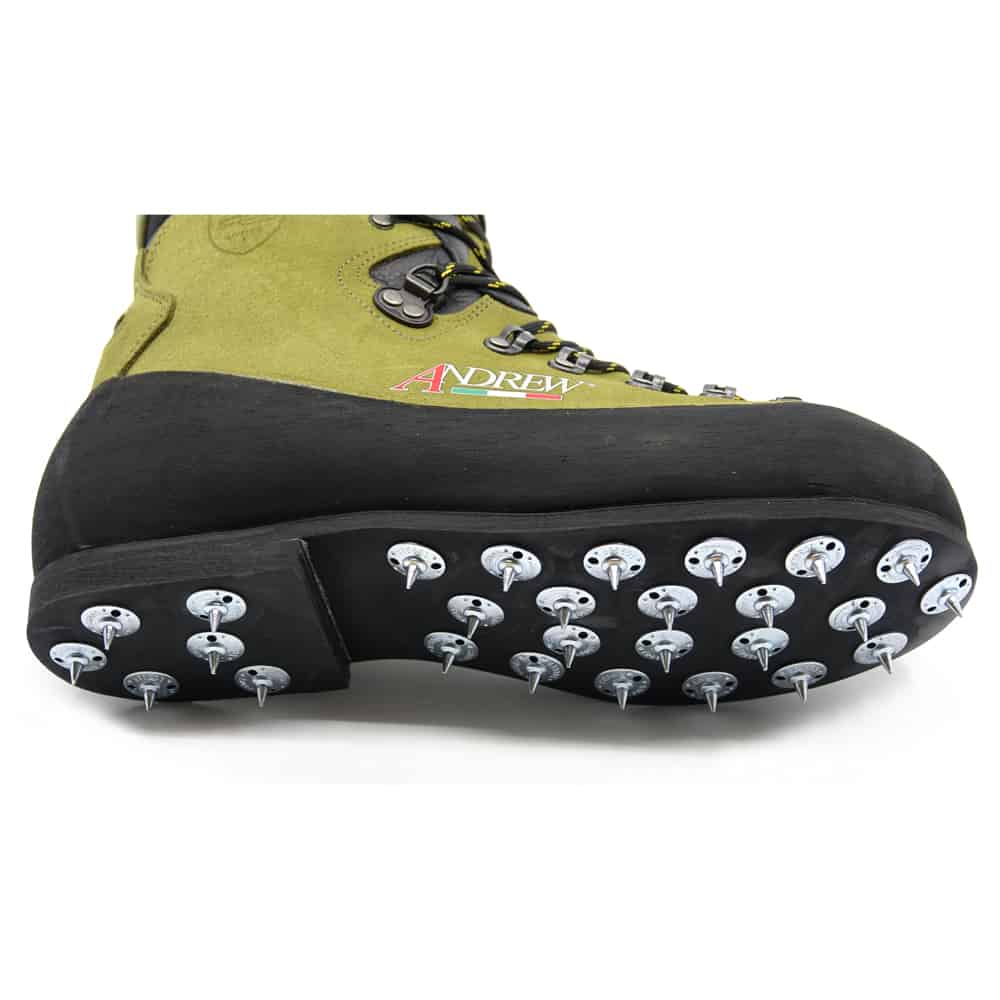
Andrew Duramax
An ultra hard all rubber block heel sole with 27 receptacles and Champ carbon steel 15/64 imperial spikes.
Giving great traction on logs and slippery surfaces.
The spikes are replaceable.
Boots with this sole:
The Leather

The Full Grain Leather
Full grain leather refers to the type of leather that has not been sanded during the tanning process. For example, a cow full grain leather is a premium leather. It’s made out of the part of the skin which comes with almost no defects, meaning, no scar, mole or any type of hole. This is why it does not need to be sanded.

The Nubuck
To make the nubuck, the outer layer of the calfskin is used, then the leather has to be sanded from the outside of the skin. The nubuck is more expensive than suede most of the time. This is because the outer layer of calfskin, is tougher than the inner part used for the suede and therefore logically is stronger and will last longer. However there is a counterpart to the nubuck, because the nubuck is sanded from the outside, there may be some apparent natural imperfections of the leather. Some might find that the imperfections give character to the nubuck, but for all the others, in order to offer a smooth and clean product, manufacturers often dye and stain the nubuck.


The Suede
In Contrary to the nubuck, the inner layer of the calfskin (or other animal skins) are used to make the Suede. The suede is also sanded from the inner side of the leather allowing a naturally smoother and cleaner product than the nubuck. But as mentioned above this also implies that when compared to nubuck, suede is not as resistant.
Many believe that suede will be damaged if wet. Although it is not advised to expose suede to too much water, your suede shoes won’t be ruined if wet. If you can, avoid going out with suede on the rainy days, but if you do, don’t worry your shoes will survive just fine. In fact suede does not require much maintenance, treating your suede shoes with water proofing products and brushing them regularly with a suede brush (the soft bristles, never the wire) to maintain the nap, the actual fibres that gives suede its character, will be enough.

Structure Plan
Starting from an attentive correspondence between the foot morphology and modelling of the shape, a rigorous procedure is followed according to which the ability and precision of assembly operations must respect the high construction and quality standards of every Andrew shoes.

